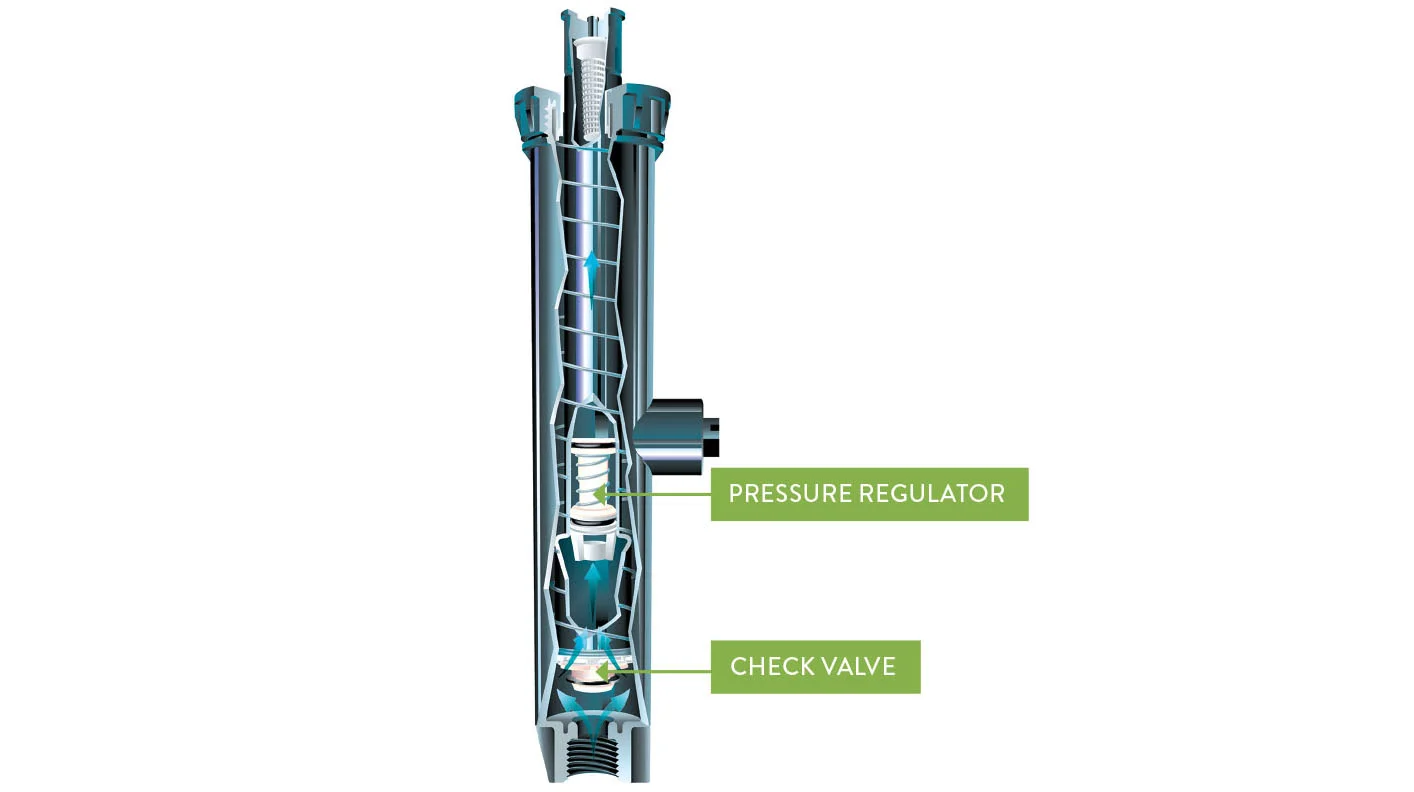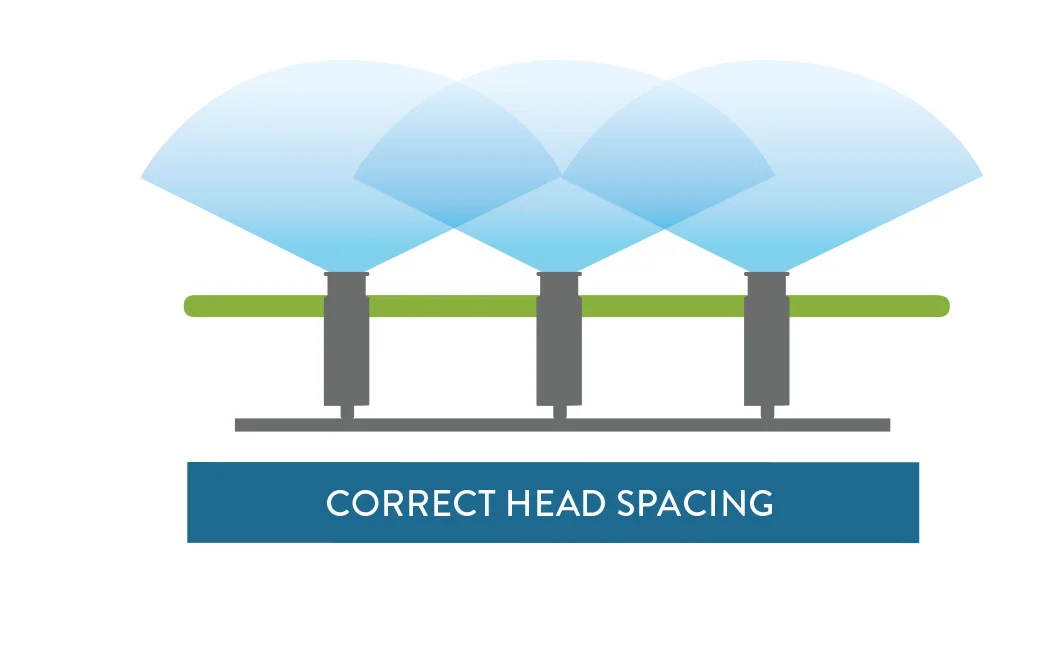Common Irrigation Problems Demystified
With just some small improvements to your irrigation system, you can reap BIG water savings.
In this section, we will discuss some of the common problems with an irrigation system and explain what improvements can be made.
PROBLEM: Leaks in your irrigation system
Check your system for leaks by reading the water meter. Turn off all of the faucets and water-using appliances inside and outside the house. Go to the meter and look to see if the indicator is spinning (Most meters are typically located at the curb in front of your house). Verify with family members that no water is running. If the meter is still spinning, this means you may have a leak. You should also review your water bill to look for trends. Most water bills show a history of water use where you can see if there has been excessive use.
Problem: Water seems to be drooling out the lowest head in a zone
Image courtesy of Rain Bird, Inc.
If the sprinkler zone has some kind of slope, even with a slight elevation change, the water from the zone collects at the lowest head then drools out. We call this “low head drainage” and it is easy to fix. Just like fixing pressure problems, if you can change a light bulb, you can change the sprinkler guts with a “check valve” feature installed into the sprinkler stem. All sprinkler head guts within a zone should be changed. If your heads are very old, you may need to upgrade to newer sprinklers
Problem: Sprinklers misting or fogging, or lawns that have green donuts
Too much pressure
Other than a big leak, sprinklers operating above their recommended pressure can cause big water losses that are not very obvious. Sprinklers will spray in a fine mist or fog that is easily blown away by the slightest breeze. A valve zone of 10 spray sprinklers operating at 20 psi higher than it should can put out an extra 100 gallons a week or more, on average, with a good portion of the water drifting off site.
Too little pressure
Operating at pressures too low causes poor spray patterns, thus increasing the need to apply more water. If the low pressure is occurring in a lawn, there will be dark green donuts of lawn surrounded by very dry lawn near the sprinkler.
The solution to this is simple. If you can change a light bulb, you can replace the guts of the sprinkler with a type that regulates pressure. All sprinkler head guts within a zone should be changed. If your heads are very old, you may need to upgrade to newer sprinklers. If the pressure is not too high, a few turns of the valve flow control stem can help reduce the pressure, but this is not ideal.
©2017 County of San Bernardino, DigitalGlobe, U.S. Geological Survey, USDA Farm Service Agency, Map data ©2017 Google
Problem: Excessively wet or dry areas
A very common problem is having excessively wet or dry areas; this is especially noticeable in a lawn.
Here are six situations that can cause uneven watering along with some remedies:
Image © Pam Pavela
1. Blocked heads
Various things can block sprinkler heads. Usually it is a plant that has grown larger, but sometimes it can be a lawn ornament unknowingly placed near a hidden pop-up head. Either the plants can be trimmed, or the sprinkler can be raised with the addition of pipe. In lawns, a common problem is pop-up sprinklers that don’t pop up high enough to clear the grass. We recommend installing 6” pop-ups. Unless you have a lawn such as hybrid bermudagrass, 4” pop-ups will not always clear the height of your grass. Then you have to dig ugly moats around each sprinkler head so they will be unimpeded.
2. Misaligned or sunken heads
These are easy to see, but can be a hassle to fix. When sprinkler heads are installed, they should include a flexible tube or fittings that create a swing joint under the sprinkler head. This allows easy adjustment of head height and alignment, and allows some defense against mower damage. Many do-it-yourselfers either don’t know or don’t bother with installing flexible fittings under the head. This makes later adjustments impossible.
3. Adjusting sprinkler nozzles too severely
When water is hitting the sidewalk or just simply reaching too far, there is a screw in the sprinkler nozzle that can be turned right to shorten the sprinkler’s throw. However, if the reduction is more than 25%, the spray pattern will be distorted. In that case, a smaller nozzle (shorter radius) is called for.
4. Mismatched nozzles and sprinkler heads
If possible, always try to have the same manufacturer and model of sprinklers and nozzles within a valve zone. Never mix different types of heads or nozzles in the same zone (like spray and rotor heads). Even different manufacturers of spray nozzles can be different. Different head and nozzle types have different rates of applying water.
5. Incorrect pressure
This is far more wasteful than it appears. Read above under “Problem: Sprinklers misting or fogging…”
6. Improper head spacing
When sprinkler heads are operating, their spray or stream of water should reach all adjacent heads. This is called “head-to-head” coverage. Many do-it-yourself sprinkler installations are installed incorrectly with gaps and crowded spacing which totally ruins any chance of uniform water application.
Problem: Runoff
Unless you have a sandy landscape soil, most soils will not allow water to soak in as fast as the water is being delivered by the sprinklers. Therefore, runoff will occur and you will be paying for water running across sidewalks and down the gutter. There is a simple remedy: cycle and soak. Program your controller to water in short durations with about 45 to 60 minutes in between each start time. For example, let’s say your landscape needs a total of nine minutes of water from spray sprinkler heads on the day you need to water. Set three start times of three minutes each, 45 minutes apart: 4:00 a.m. for 3 minutes, 4:45 a.m. for 3 minutes, and 5:30 a.m. for three minutes.
Another option is to change your sprinkler nozzles to rotating sprinkler nozzles which apply water at a much slower rate. Make sure you replace the current nozzles with rotating nozzles that throw the same distance. You want the water from one sprinkler to reach each adjacent sprinkler. Additionally, you will need to change all of the nozzles in the same zone or you will end up with very dry and wet spots. How long can you water at one time with rotary nozzles? It depends on your soil type. Turn on the rotary zone and time how long it takes to see runoff. Subtract one minute; this is the maximum run time. If you need more minutes, take the total minutes needed and divide between two start times. Allow 45 to 60 minutes between the time the sprinklers are watering.
Problem: The sprinklers are throwing too far, hitting the sidewalk
If you just need to reduce the distance a little, you can use an adjustment screw in the sprinkler nozzle. Please note that you can only reduce the throw by only a few feet (or 25%) otherwise the pattern will be become distorted. The other method would be to replace the nozzle with a shorter throw nozzle to better cover the area without overwatering onto a walkway or driveway.
Problem: Watering during rain
Install a rain shut-off device. They are inexpensive, simple to install, and come in both wired and wireless models.
Still having issues?
When your irrigation is inefficient and several problems need to be addressed, it may be time to contact a professional contractor that specializes in irrigation renovations. Here is an example: You operate a valve and all the sprinkler heads do not pop up completely. You referred to the Troubleshooting Guide and have determined that you have too many sprinklers on the zone. In this situation another valve is needed. This will result in each zone having fewer sprinklers, more flow, and better pressure. We call this “splitting the zone.” This requires running new pipe, adding a new valve, and running new controller wires from the new valve to the controller.
A variation to this problem is having different sprinkler types on the same valve or zone. For example, you might have six spray sprinklers covering a smaller area, four rotating sprinklers covering a larger area, and all operated by one valve. Different types of sprinkler heads or nozzles should never be operated on the same zone or valve. The spray sprinkler area will always get too much water compared to the rotor area. Therefore, the valves need to be split as described above so that all spray sprinklers are on one valve, and all rotors are on a separate valve. Drip irrigation should always be operated from its own dedicated valve. Not only does it deliver water at a much slower rate than sprinklers, the valve should have a filter that is not necessary for sprinkler irrigation.
Tools to Learn More
For those of you who want to learn the nuts and bolts of irrigation design, here is a classic book that is NOT too technical and easy to understand. It is long (130 pages) but thorough.
Almost all irrigation manufacturers have their own websites with guides and instruction manuals. Many also have easy-to-understand online videos on their various products.









